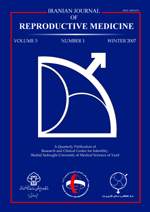
|
International Journal of Reproductive BioMedicine
Research and Clinical Center for Infertility, Shahid Sadoughi University of Medical Sciences of Yazd
ISSN: 1680-6433
EISSN: 1680-6433
Vol. 19, No. 5, 2021, pp. 477-482
|
 Bioline Code: rm21047
Bioline Code: rm21047
Full paper language: English
Document type: Case Report
Document available free of charge
|
|
|
International Journal of Reproductive BioMedicine, Vol. 19, No. 5, 2021, pp. 477-482
| en |
Prenatal diagnosis of de novo small supernumerary marker chromosome 4q (4q11-q12): A case report
Mohammadi, Reza; Taheri, Raheleh; Shahriyari, Fatemeh; Feiz, Farnaz; Mohammadi, Zahra; Shirian, Sadegh; Raoofian, Reza; Malekpour, Abdorrasoul & Pazhoomand, Reza
Abstract
Background: Small supernumerary marker chromosomes (sSMCs) are chromosomal fragments with abnormal structures found in patients with fertility problems and developmental delay. They may be detected in amniotic cell karyotypes. sSMCs are categorized as hereditary or de novo. Here, we describe a case of prenatal de novo 4q11q12 sSMC and its molecular cytogenetic features which had no apparent phenotypic abnormality.
Case: The fetus of a 36-yr-old pregnant woman was detected positive for Down’s syndrome (trisomy 21) at the 16th wk of gestation. Quantitative fluorescent polymerase chain reaction technique was applied for the rapid detection of numerical aneuploidy of chromosomes X, Y, 13, 18, and 21 microsatellites. Array comparative genomic hybridization (array CGH) technique was also conducted following the karyotype analysis of amniotic cells. The karyotype analysis was also done for the parents. Quantitative fluorescent polymerase chain reaction result revealed a male fetus with a normal chromosomal pattern, while the amniocentesis karyotype analysis identified a male fetus with a marker chromosome (47, XY, +mar), and the sSMC were existing in 100% of amniocyte metaphase spreads. The parents’ normal karyotypes indicated that the sSMC was de novo. Array CGH analysis revealed a 6.48-Mb duplication at 4q11q12. Eventually, the parents decided to terminate the pregnancy by legal abortion.
Conclusion: Our study highlights the importance of the application of array CGH in combination with karyotype analysis for rapid and precise prenatal diagnosis of partial aneuploidy region.
Keywords
Prenatal diagnosis; Array CGH; Chromosome 4; Chromosome markers.
|
| |
© Copyright 2021 - Mohammadi et al.
Alternative site location: http://www.ijrm.ir
|
|
